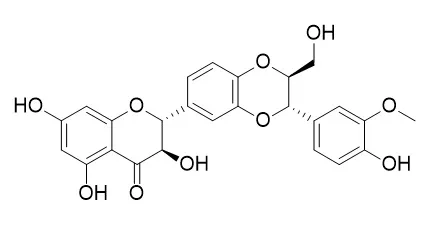Women at high risk of developing breast cancer are prescribed selective estrogen response modulators, including raloxifene, as chemoprevention. Patients often seek complementary and alternative treatment modalities, including herbal products, to supplement prescribed medications. Milk thistle preparations, including silibinin and silymarin, are top-selling herbal products that may be consumed by women taking raloxifene, which undergoes extensive first-pass glucuronidation in the intestine. Key constituents in milk thistle, flavonolignans, were previously shown to be potent inhibitors of intestinal UDP-glucuronosyl transferases (UGTs), with IC50s ≤ 10 μM. Taken together, milk thistle preparations may perpetrate unwanted interactions with raloxifene.
METHODS AND RESULTS:
The objective of this work was to evaluate the inhibitory effects of individual milk thistle constituents on the intestinal glucuronidation of raloxifene using human intestinal microsomes and human embryonic kidney cell lysates overexpressing UGT1A1, UGT1A8, and UGT1A10, isoforms highly expressed in the intestine that are critical to raloxifene clearance. The flavonolignans silybin A and Silybin B were potent inhibitors of both raloxifene 4'- and 6-glucuronidation in all enzyme systems. The Kis (human intestinal microsomes, 27-66 µM; UGT1A1, 3.2-8.3 µM; UGT1A8, 19-73 µM; and UGT1A10, 65-120 µM) encompassed reported intestinal tissue concentrations (20-310 µM), prompting prediction of clinical interaction risk using a mechanistic static model. Silibinin and silymarin were predicted to increase raloxifene systemic exposure by 4- to 5-fold, indicating high interaction risk that merits further evaluation.
CONCLUSIONS:
This systematic investigation of the potential interaction between a widely used herbal product and chemopreventive agent underscores the importance of understanding natural product-drug interactions in the context of cancer prevention. |






 Cell. 2018 Jan 11;172(1-2):249-261.e12. doi: 10.1016/j.cell.2017.12.019.IF=36.216(2019)
Cell. 2018 Jan 11;172(1-2):249-261.e12. doi: 10.1016/j.cell.2017.12.019.IF=36.216(2019) Cell Metab. 2020 Mar 3;31(3):534-548.e5. doi: 10.1016/j.cmet.2020.01.002.IF=22.415(2019)
Cell Metab. 2020 Mar 3;31(3):534-548.e5. doi: 10.1016/j.cmet.2020.01.002.IF=22.415(2019) Mol Cell. 2017 Nov 16;68(4):673-685.e6. doi: 10.1016/j.molcel.2017.10.022.IF=14.548(2019)
Mol Cell. 2017 Nov 16;68(4):673-685.e6. doi: 10.1016/j.molcel.2017.10.022.IF=14.548(2019)